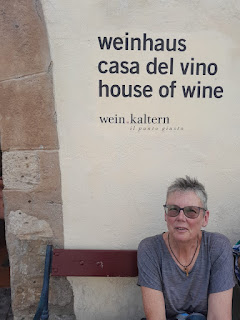Von Bozen auf Trient geht es neun Meilen weg in einem fruchtbaren und fruchtbareren Tale hin. Alles, was auf den höheren Gebirgen zu vegetieren versucht, hat hier schon mehr Kraft und Leben, die Sonne scheint heiß, und man glaubt wieder einmal an einen Gott.
(From Bolzano to Trento one travels for nine miles through a country which grows ever more fertile. Everything which, higher up in the mountains, must struggle to grow, flourishes here in vigour and health, the sun is bright and hot, and one can believe again in a God.)
- Goethe, Italienische Reise (Italian Journey), 11 September 1786
Wine in Kaltern/Caldaro
Kalterersee wine is made from the Vernatsch grape, the oldest red wine varietal of the South Tyrol region. It is a fruity wine best drunk young, served lightly chilled as an accompaniment to a great variety of dishes.
The second most typical variety of the region is Lagrein, grown in the red wine vineyards around the lake, which gives it its distinctly fruity character. International varieties such as Cabernet Sauvignon and Merlot also benefit from the uniquely warm and temperate conditions around the lake, where the temperature remains relatively constant even during the night. Pinot Noir is different: this elegant red wine needs a cool, dry location for its full aromatic development and is therefore traditionally cultivated further away from the lake. White wines also benefit from the temperature variations that exist in Kaltern's northern, higher altitude vineyards in order to develop the perfect balance between fruitiness and acidity. Varieties that thrive in the area include here White Burgundy, Chardonnay, Ruländer/ Pinot Grigio, Sauvignon Blanc Müller Thurgau, Gewürztraminer and Coldmuskateller.
We left the vineyards behind to walk a four-kilometre "nature trail" through the edge of the forest, just above the vineyards but in the shade, coming out into the town of Termeno, or Tramin. As in Gewürztraminer! Gewürz means spicy or, in this case, aromatic, and Traminer is of course the wine of Tramin. I sampled a glass at a local bar, but not before climbing to the top of the hill above the town - covered with vineyards, naturally - to visit the church of St. Jakob in Kastelaz, dedicated to St. James, patron saint of pilgrims. Built around the year 1240, the small church is decorated with some of the oldest Romanesque frescoes in the German-speaking world, depicting mythical beasts, scenes from the life of Christ and legends associated with St. James, as well as a charming depiction of David killing Goliath.
We carried on another four kilometres from Tramin/Termeno to Kurtatsch or Cortaccia along a scenic path hugging the edge of the ridge, with fantastic views over the broad valley of the Adige river. Vineyards were planted all the way up from the valley floor to the top of the ridge, and in fact the vineyards of Kurtatsch have a greater difference in altitude within a single municipality than anywhere else in Europe. Steep slopes with different soils and exposures result in very different distinctive wines, truly reflecting their place of origin.
 |
| So many wines, so little time! |
 |
| Hot and sweaty, waiting for the Citybus |
Upon arriving in the town of Kurtatsch we caught the first Citybus back to Tramin, then another bus from there to Kaltern an der Weinstraße, or Caldaro sulla Strada del Vino, the town above the lake we had walked beside. We had time for a quick look around the town before catching another Citybus to San Michele Appiano and walking up the hill to our hosts' home. We enjoyed a dinner of pasta with vegetables out on the patio before it began to rain, and now we are tucked cosily in bed, listening to the rain striking against the windowpanes and the thunder rolling around the valley.
Montigglersee - Kurtatsch 18 km



















Sembra esser una zona bellissima!
ReplyDeleteÈ una zona bellissima
ReplyDelete